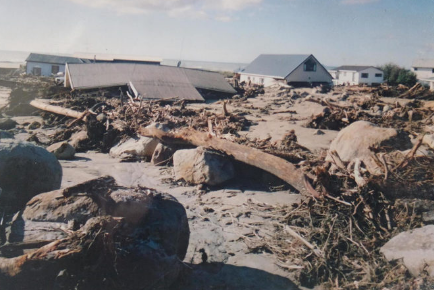Floods in Guayaquil and Manta, drought in Cuenca and Quito? Ecuador prepares for El Niño
With the official announcement Thursday that the El Niño weather phenomenon has begun, Ecuador’s Risk Management Secretariat issued a yellow alert for 143 cantons and 439 parishes it considers vulnerable to flooding.

In addition to the destruction of homes and businesses, the 1998 El Niño also destroyed much of Ecuador’s fishing fleet.
In its announcement, the United States Oceanic and Atmospheric Administration (NOAA) said El Niño is strengthening rapidly in the Pacific Ocean due a rise in seawater temperatures and could have a “major weather impact worldwide” in the second half of 2023 and possibly early 2024. “We expect this El Niño to be above average in intensity and possibly extremely intense,” NOAA said in its statement. It added that it will provide a more detailed forecast in late July and August.
According to the Ecuador Risk Management office, areas put on alert are the Pacific Ocean coast, the adjacent littoral and the western area of the country at elevations under 1,500 meters. “The lower the elevation and the closer to the ocean means greater risk in the event of a strong El Niño,” the Secretariat. In a strong El Niño, the higher elevation of the Andean region should prepare for drought conditions, it adds, severely affecting agricultural interests.
The provinces at greatest risk, Risk Management says, are Esmeraldas, Santo Domingo de los Tsáchilas, Manabí, Los Ríos, Guayas, Santa Elena, El Oro and Galápagos. In addition, lower elevations of Azuay, Bolívar, Cañar, Carchi, Chimborazo, Cotopaxi, Pichincha, Imbabura and Loja could also experience flooding.

Guayaquil suffered extensive flood damage in the 1997-1998 El Niño.
According to Roque Mendoza, retired director of Ecuador’s Civil Defense Service – now the Risk Management Secretariat — 1997-1998 offers lessons for the potential severity of El Niño. “That was the strongest El Niño in the last 100 years and we were not prepared for it,” he says. “This time, we have more data and more warning.”
The lack of preparation in 1997, says Mendoza, was mostly due to a lack of information. “We knew much less about El Niños then although there had been other, less severe events in the 1970s and 1980s. The fact is, we were not ready.”
More than 300 people died the floods and landslides in 1998 and more than 3,000 buildings were destroyed, leaving 30,000 homeless, Mendoza says. “We lost our railroad system, which was never rebuilt, and hundreds of miles of roads. We had towns isolated for months after the floods as the result of landslides and were sending in food and other supplies by boat and helicopter to keep people alive. Besides the material destruction, there thousands of cases of dengue fever and malaria following the floods, as well as hundreds of snakebites.”
In total destruction, Mendoza says, the 1997-1998 El Niño had “twice the economic impact” of the 21016 Manabí earthquake.
In issuing its yellow alert Thursday, Risk Management said communities in the risk area should review their disaster plans, provide updated training for emergency personnel and conduct emergency drills. “Now is the time to make plans,” it said in its directive. “Based on the meteorological reports, we believe there is an 80% or greater probability that this El Niño will have an above-normal impact.”
Risk Management added: “We are already conducting remediation in areas affected by seasonal rains, particularly in Esmeraldas Province, so we many of our procedures are already in operation.”
Mendoza warns of complacency as the new El Niño develops. “Several times in the past 25 years we have been told that a strong El Niño is coming but these have been relatively weak events,” he says. “It’s possible this will be the same, but early indications are that it will be strong. There is no excuse for not being prepared.”





















